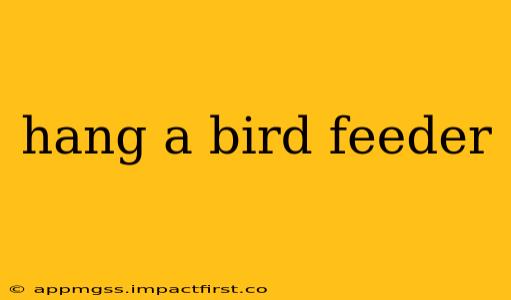Attracting birds to your backyard is a rewarding experience, offering hours of entertainment and a closer look at nature's wonders. A well-placed bird feeder is key to this endeavor. However, simply hanging a feeder isn't enough; proper placement and consideration for safety are crucial for both the birds and your enjoyment. This comprehensive guide will walk you through the process, answering common questions and ensuring your feathered friends have a safe and enjoyable dining experience.
What is the Best Place to Hang a Bird Feeder?
The ideal location for your bird feeder depends on several factors. You want to maximize visibility for you while providing a safe haven for the birds. Consider these points:
-
Predator Protection: Cats, raccoons, and other predators pose a significant threat. Hang your feeder at least 4-6 feet away from trees or shrubs that predators could use to ambush birds. Ideally, position the feeder where it's visible from a window, allowing you to monitor for predators.
-
Weather Protection: Choose a location that offers some protection from harsh weather conditions like rain, snow, and strong winds. A covered porch or overhang can be ideal. Avoid placing the feeder in direct sunlight, as this can cause food to spoil faster.
-
Accessibility: While ensuring predator protection, make sure the feeder is easily accessible for refilling and cleaning. Avoid locations that require you to climb ladders or maneuver through obstacles.
What Kind of Bird Feeder Should I Use?
The type of bird feeder you choose will depend on the types of birds you want to attract and your personal preferences. There's a wide variety available, each with its own pros and cons:
-
Tube Feeders: These are popular and efficient, holding numerous feeding ports to accommodate multiple birds.
-
Hopper Feeders: These provide larger quantities of seed, reducing the frequency of refills.
-
Platform Feeders: These are simple and easy to clean, suitable for various bird species, but may attract larger ground-feeding birds and rodents.
-
Suet Feeders: These are great for providing high-energy food, especially in winter.
How High Should I Hang a Bird Feeder?
The height at which you hang your feeder is a balance between predator protection and bird comfort. Aim for a height of at least 4-6 feet from the ground, but consider the surrounding vegetation. If you have tall trees nearby, you may need to hang the feeder higher to deter predators. However, remember, very high feeders can make it difficult for smaller birds to reach.
What Should I Use to Hang a Bird Feeder?
Several options exist for hanging your bird feeder, each with its advantages:
-
Hooks: Simple and effective, especially for hanging from tree branches or shepherd's hooks. Ensure the hook is sturdy enough to support the weight of the feeder and its contents.
-
Wire: Provides flexibility in placement, allowing you to hang the feeder from various structures. Use strong, weather-resistant wire to avoid breakage.
-
Existing Structures: Utilize existing structures such as fences, deck railings, or overhanging eaves. Use appropriate mounting hardware for secure attachment.
How Often Should I Clean My Bird Feeder?
Regular cleaning is essential to prevent the spread of disease among birds. Aim to clean your feeder at least once a month, or more frequently during warm, humid weather. Remove any spoiled food, droppings, and debris. Wash the feeder thoroughly with soap and hot water, and allow it to air dry completely before refilling.
What Kind of Birdseed Should I Use?
Different birds prefer different types of seeds. Research the types of birds common in your area to determine their preferred food sources. A mix of seeds usually attracts a wider variety of birds. Avoid using moldy or spoiled seeds.
By following these guidelines, you'll be well on your way to creating a thriving bird sanctuary in your backyard. Enjoy the beauty and wonder of nature right outside your window!
